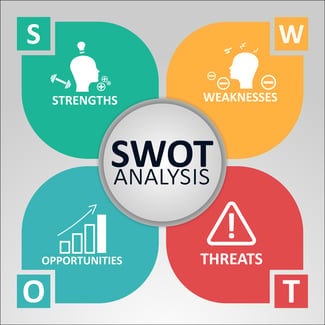SWOT analysis is a strategic planning tool used by businesses and organizations to identify and analyze their strengths, weaknesses, opportunities, and threats. It is an essential tool for developing and implementing effective strategies to achieve organizational goals and objectives. In this blog, we will discuss SWOT analysis, its components, and how to conduct it.
What is SWOT Analysis?
SWOT analysis is a structured approach to analyzing an organization’s internal and external environment. It involves identifying the organization’s strengths, weaknesses, opportunities, and threats. The analysis provides insights into the organization’s current situation and helps identify areas for improvement and growth.
SWOT analysis is an acronym for:
Strengths: Internal factors that give the organization an advantage over its competitors.
Weaknesses: Internal factors that put the organization at a disadvantage compared to its competitors.
Opportunities: External factors that the organization can capitalize on to achieve its goals.
Threats: External factors that can hinder the organization’s ability to achieve its goals.
Components of SWOT Analysis
Strengths
Strengths are the internal factors that give the organization an advantage over its competitors. These can include:
Skilled and experienced employees
Strong brand reputation
Unique products or services
Effective marketing strategies
Robust financial position
Strong partnerships and collaborations
Weaknesses
Weaknesses are the internal factors that put the organization at a disadvantage compared to its competitors. These can include:
Lack of skilled workforce
Poor financial management
Outdated technology
Weak marketing strategies
Inefficient processes and systems
Poor brand reputation
Opportunities
Opportunities are external factors that the organization can capitalize on to achieve its goals. These can include:
Emerging markets and new customer segments
Technological advancements
Economic growth and stability
Changes in consumer preferences and behavior
Strategic partnerships and collaborations
Changes in regulatory environment
Threats
Threats are external factors that can hinder the organization’s ability to achieve its goals. These can include:
Intense competition
Economic downturns and instability
Changing consumer preferences and behavior
Technological disruptions
Changes in regulatory environment
Natural disasters and other unforeseen events
How to Conduct SWOT Analysis?
SWOT analysis can be conducted through a simple and structured process. Here are the steps involved:
Define the objective
Start by defining the objective of the analysis. This can be a specific project, product, service, or the overall organization.
Gather information
Gather information about the internal and external factors that can impact the objective. This can be done through internal discussions, market research, customer feedback, and industry reports.
Identify strengths and weaknesses
Identify the strengths and weaknesses of the organization in relation to the objective. This can be done through brainstorming and discussion with relevant stakeholders.
Identify opportunities and threats
Identify the opportunities and threats that the organization may face in relation to the objective. This can be done by analyzing the external environment, such as market trends, competitors, and regulatory changes.
Analyze the results
Analyze the results of the SWOT analysis to identify key areas for improvement and growth. Use the insights to develop strategies and action plans to address the identified issues.
Conclusion
SWOT analysis is a powerful tool for identifying and analyzing the internal and external factors that can impact an organization’s performance. It provides valuable insights into the organization’s strengths, weaknesses, opportunities, and threats, and helps develop effective strategies to achieve organizational goals and objectives. By conducting SWOT analysis, organizations can make informed decisions, capitalize on opportunities, mitigate threats, and achieve long-term success.




